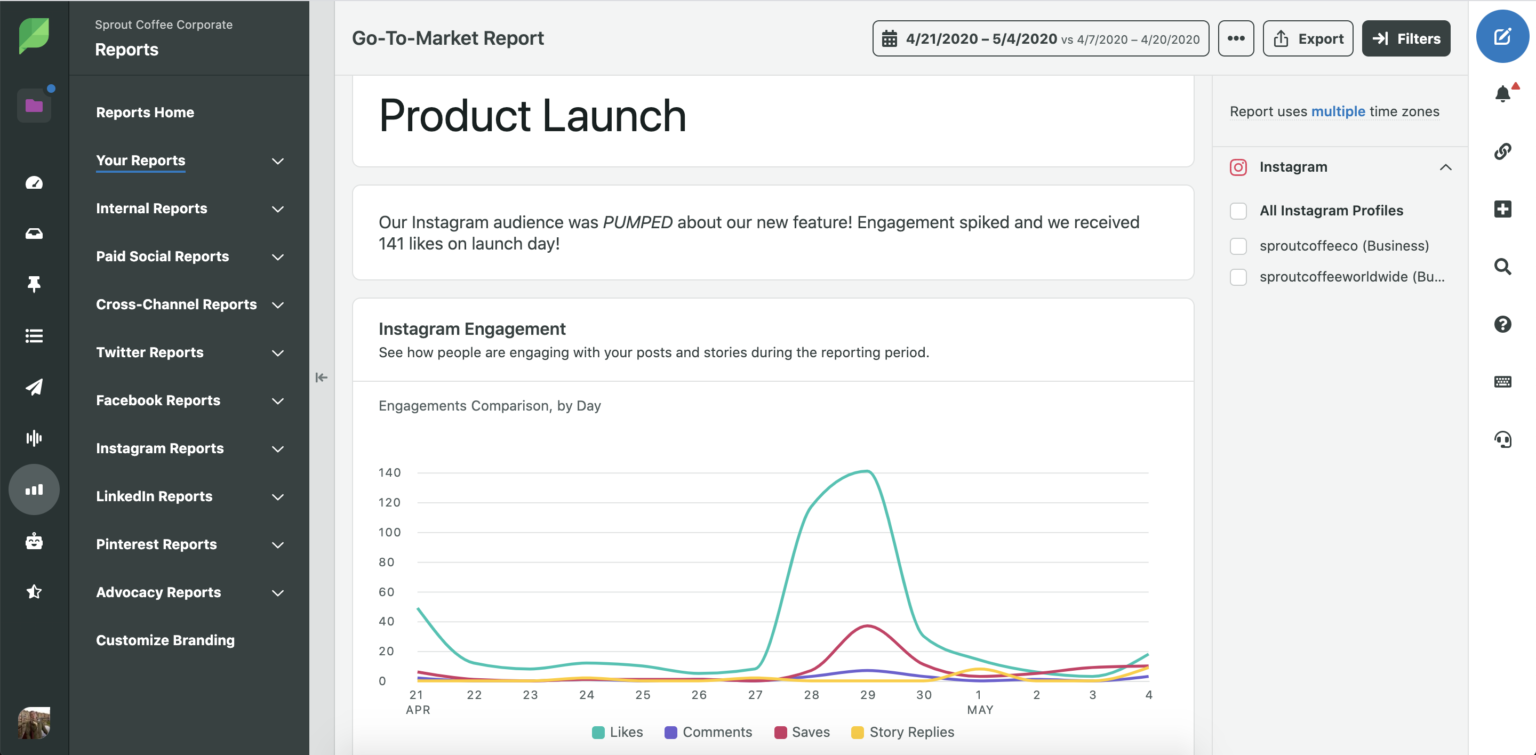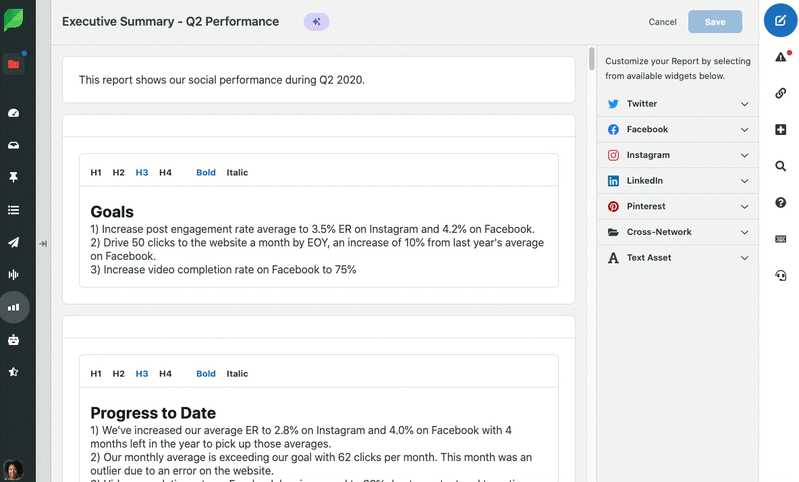It’s happening. Businesses are starting to recognize the true value of social media.
More than half of executives predict that social media will become the most important source of data to inform company business decisions over the next three years. This recent surge in leadership buy-in presents a huge opportunity for enterprise social teams. It also creates more work. After all, more data means more time spent reporting.
Managing reporting requests from stakeholders operating within different brands, business units and regional divisions is tricky, but possible with the right foundation. With a robust social analytics solution, marketers can create meaningful reports that travel across a business without risk of misinterpretation or confusion.
As you prepare your team to become the primary bearers of business intelligence, here are four strategies you can use to ensure your data is always digestible and, most importantly, actionable.
1. Take advantage of reporting templates
Enterprise social teams are constantly juggling reporting requests from different areas of their business. Where one business unit might be looking for total link clicks in a campaign, another might be more interested in the overall engagement rate or post impressions.
Of course! And really, every report should be tailored to its audience. That’s not to say you cherry-pick data, gloss things over or leave critical things out, but organize for relevance, use terms your audience understands and make reports directly actionable.
— Josh B. Vaxxed (@JoshEdits) September 8, 2020
This leaves marketers with two less-than-desirable options. You can either create multiple tailored reports each month, monopolizing hours that could be spent on strategic initiatives, or you can send one all-encompassing report knowing that your efforts might be misinterpreted by key stakeholders.
That’s where templates come in. Creating a social media report template based on the unique needs of different audiences saves time and creates opportunities to delegate work to other team members. Templates can be easily created and saved in tools like Google Docs, Slides or Excel, depending on your preferred presentation style.
You can also use a social media management solution like Sprout Social to build and store custom reports. Sprout’s Report Builder tool uses data already available in Sprout to create reports specific to your business needs. Best of all, they can be used again and again to speed up your reporting process.

2. Include an executive summary
Once your report leaves your outbox, there’s no telling where your data will end up. It’s not uncommon for well-meaning collaborators to share reports with other interested parties. Unfortunately, that leaves you open to a lot of follow-up questions, most of which you probably already answered during your initial presentation.
That’s why sharing reports with context is so important. Data without a story can mean anything. For example, an uptick in brand mentions quarter-over-quarter could mean people are loving your service, but it also could mean people are making public complaints.
To make sure your data is always framed with the big picture in mind, include an executive summary. Executive summaries provide a brief overview of report findings, allowing you to control your data narrative.

One of my favorite benefits of Sprout’s Premium Analytics is the text elements available in our custom reports. You can use them to add in context that showcases the full ROI of social, including benchmarks, data from Google Analytics and more. It elevates a report so that anyone seeing it can understand it without having to interpret the metrics themselves.
3. Create a data glossary
Your team and marketing department are probably fully aligned on your KPIs and how they differ across business units. You know what your progress means and how it all ladders up into business goals.
People beyond your marketing department, on the other hand, probably don’t live and breathe social metrics the same way you do. They may understand how an engagement differs from a click, but they don’t know how that connects back to department and company goals.
With a data glossary, you can attach a quick recap of the “why” behind your goals with every report that you send. Typically, a formal data glossary is a collection of all the terms that define your data across systems. These are often large undertakings led by an IT department, but creating a simpler, marketing-specific version can be done quickly and with minimal effort.
All you need to do is compile information from when you first set your quarterly or yearly objectives and KPIs. Sorting that in a table format, with a quick recap of each KPI and how it supports a business or marketing objective, can provide external stakeholders with all the information they need to contextualize your reports accordingly. Here’s an example of what an entry could look like:
Impressions: A reach metric that tracks how many times a post or profile has been seen. Our quarterly and annual impressions goals ladder up to the marketing department’s brand awareness goal.
You can also use your data glossary as a document hub that links out to benchmark data, more in-depth social media KPI explainers and strategy documents to encourage interested parties to learn more about team initiatives.
4. Share reports proactively
Social media is fundamentally changing how businesses operate and deliver value to their customers. The unfiltered view into consumer needs, cultural relevance, industry trends and competitive intelligence can drive enterprise wide strategic alignment. Yet, only 8% of marketers say that data is viewed as an organization wide business intelligence resource.
Have you ever heard the phrase “you don’t know what you don’t know”? Many businesses aren’t leveraging social data to its full capacity simply because they aren’t aware of the types of insights it can provide. Leading with social data starts with you. With a little bit of foresight, you can create teaching moments that showcase the value of your efforts in a way that directly ties to business impact.
? When an entire organization learns to embrace social data, they’ll discover the path forward to rapid growth—and marketers will be the ones to show them the way.
— Sprout Social (@SproutSocial) June 28, 2021
Proactively sharing social data (especially with those who might not have asked for it) can help you lay the groundwork for future strategic initiatives while maintaining control over where your data goes and how it is shared. On top of that, it’s as easy as a quick CC or a scheduled PDF send.
Let your social data lead the way
Social media is the future of business intelligence. Now is the time to break away from enterprise silos and democratize your data for maximum use. Platforms like Sprout Social can help you share reports quickly and effectively, so you can spend more time on the strategy driving the insights. See what Sprout can do for you by setting up a personalized demo with one of our experts today.
The post Enterprise social media reporting: How to make your data credible, digestible and actionable appeared first on Sprout Social.

